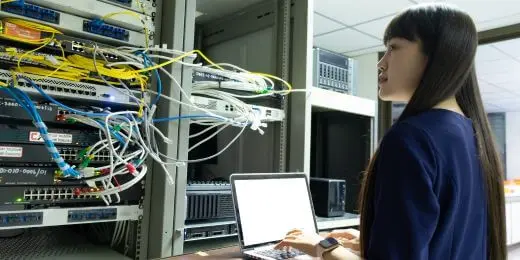What is Internet Safety?
Internet safety is the practice of following the best practices and actionable guidelines when using the internet. This is to ensure that people stay safe from scams, viruses, data breaches, and other threats when browsing the web. While it also applies to individuals, internet safety is very important for organizations, especially with almost all workplaces connected to the internet one way or another. The internet is packed with all the information you need to learn, but it also has a fair amount of risks, which is why it’s important to practice internet safety.
To establish a culture of internet safety in the workplace, it’s important to have a good understanding of what the internet is and how it’s used within your organization. That way, you can build guidelines and best practices that employees can follow when using the internet to keep themselves and your organization as safe as possible when browsing.
Importance
The internet is full of risks that can do a lot of harm to individuals and organizations. For example, one of the biggest risks an organization faces when employees need to use the internet for daily tasks is a virus that can damage or steal their data. Companies deal with a lot of sensitive data that cannot be compromised or lost. And if there aren’t enough internet safety practices in the organization, this data is at risk of getting targeted by viruses.
We’ll get into the other risks of using the internet later, but it’s important to understand that internet safety practices are essential to keep these risks at bay. That way, the organization can utilize and take advantage of all the information and benefits the internet has to offer without putting its data and systems at risk.
What Are the Risks of Using the Internet?
As mentioned earlier, the internet is full of risks to organizations and individuals. Internet safety is essential for keeping these risks at a distance and making sure that employees and your organization’s data aren’t exposed to unnecessary risks.
Generally, data breaches are some of the biggest concerns of organizations when they connect to the internet. However, many other risks serve as the reason why internet safety practices and controls are essential for organizations.
Here are some of the most common risks that organizations face when using the internet:
- Viruses that infect the computer and compromise data and entire systems
- Malware and spyware which gathers information without the person’s knowledge that individuals can use for personal gain
- Cyberstalking which is commonly used to threaten or harass an organization
Accessing and using the internet in an unsafe manner makes you and your organization more vulnerable to these risks. This is why teams need to take the time and put in the effort to create proper internet safety controls that allow them to access the internet safely and securely.
Improve your GRC management
Simplify risk management and compliance with our centralized platform, designed to integrate and automate processes for optimal governance.
Explore nowInternet Safety Tips
Every organization should approach internet safety in a way that serves their needs. Since each organization uses the internet differently, internet safety plans and controls will look different for each one.
That said, here are a few tips that all organizations should keep in mind when creating their internet safety protocols to ensure that they cover all bases and that everyone is kept as safe as possible.
Create a Cyber Security Plan
If you’re looking to create a safer online environment for employees and an organization, it’s important to craft a cybersecurity plan. These plans are specifically designed to cover your organization’s needs and address specific risks that you face when employees go on the internet.
When creating a cyber security plan, make sure that you consider the risks that the organization faces. The plan should be tailored to your needs and address specific risks that may be unique to your company and industry.
Create your own Cyber Security Checklist
Build from scratch or choose from our collection of free, ready-to-download, and customizable templates.
Browse Cyber Security ChecklistsTrain Employees
Another way to ensure that employees and company data remain safe when browsing the web is to train employees in internet safety. While you can put many controls in place to mitigate risks on the internet, it’s very important that everyone in the company that uses the internet understands how to do so safely to protect themselves and the company.
Thorough training of employees in internet safety may take some time and effort. However, rest assured that it will all be worth it, as this creates a much safer digital environment for your employees and reduces the major risks associated with connecting to the internet.
Control Physical Access
It’s important to make sure computers and similar systems cannot be accessed by unauthorized individuals. This is why we recommend finding ways to control physical access to servers and computers when not in use. This could be in the form of locking doors or even having locked storage areas specifically for devices connected to the internet.
Require Strong Passwords
A huge part of internet safety is strong passwords. One of the easiest ways for hackers to get into an account or system is by stealing a password. And if a password is simple, it will be much easier for hackers to guess the actual password without even stealing anything from you.
This is why you shouldn’t take a strong password for granted. If you want to access the internet safely within your organization, make sure that everyone uses strong passwords. This is especially true for company email addresses, as hacking into a company email account allows people to access endless amounts of data.
Always Upgrade or Update Systems
Keeping systems up to date is very important for internet safety. This includes operating systems, anti-viruses, and other programs on company computers. Keeping everything updated or upgrading systems to the best options possible creates another safety layer for the company, which is essential when browsing the web.
FAQs about Internet Safety
Computer viruses are, by far, the biggest and most common threat that organizations and individuals face when using the internet. These viruses can do everything from crashing your entire system and stealing information to locking your computers and barring access to your data.
A great example of positive internet safety is never divulging personal information. Details such as your full name, contact number, and address can all be used to steal data from you and the company, which is why it’s important to never disclose this information when on the internet.
Some of the things you shouldn’t do on the internet include:
- disclosing personal information;
- saving all your passwords in one unsecured place;
- downloading files without scanning for viruses; and
- using the internet without proper knowledge of internet safety.
While it may be confusing, e-safety and online safety are the exact same thing. These concepts pertain to protecting yourself when using the internet and keeping scams, viruses, and other common internet threats at bay.




